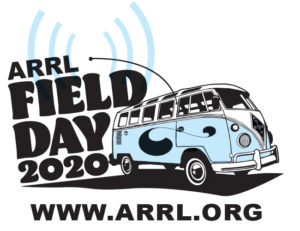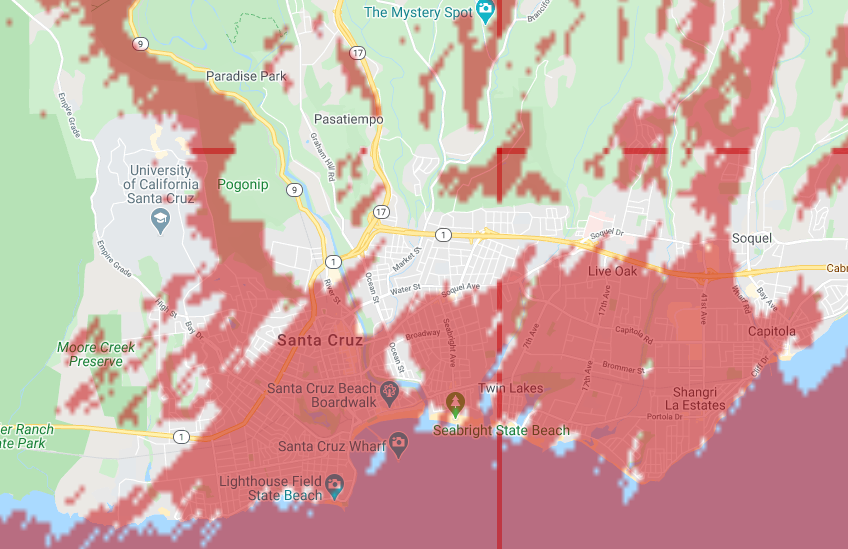 This year’s annual ARRL Field Day event has morphed into Field Day with Social Distancing. County health departments along with the United States CDC continue to recommend social distancing, face covers, disinfecting frequently used objects and surfaces, among other actions, to help slow the spread of the COVID-19 illness (Santa Cruz, Santa Clara, CDC). Consequently, our local Field Day 2020 activities have been adjusted to conform to health-department recommendations.
This year’s annual ARRL Field Day event has morphed into Field Day with Social Distancing. County health departments along with the United States CDC continue to recommend social distancing, face covers, disinfecting frequently used objects and surfaces, among other actions, to help slow the spread of the COVID-19 illness (Santa Cruz, Santa Clara, CDC). Consequently, our local Field Day 2020 activities have been adjusted to conform to health-department recommendations.
Below I discuss several ways that you can participate during Field Day 2020. Unlike most years, this year we won’t have a large pot-luck dinner, and we won’t be inviting the public to a portable Field Day setup, but you can operate from your home, you can sign up to visit the minimal portable Field Day setup that we are planning, and you can operate from your ham-radio-ready vehicle.
Operate from Your Home Station or Vehicle
If you already make amateur-radio contacts from home or a vehicle, then you can make Field Day contacts! You haven’t done this before? There are many How-To videos posted on Youtube about Field Day. Do a search, and see what you find.
Bands
The Field Day rules state that the event uses the bands 160 m, 80 m, 40 m, 20 m, 15 m, and 10 m. In addition, you can make contacts over bands with frequencies 50-MHz and above (6 m, VHF, UHF, etc.). Just be sure to operate in accordance with your license.
Modes
Field Day contacts can be made using phone (voice), digital, and CW (morse) modes. Check the Band Plan for the appropriate frequencies to use within each band.
VHF FM Contacts
Consider making a few simplex VHF contacts over FM using your handheld, base-station, or mobile VHF ham radio. The SCCARC/SLVARC Field Day site (described later) occasionally will be calling CQ on 146.46 MHz using a high-gain VHF antenna pointed toward Santa Cruz, and so if you are in or near the city of Santa Cruz, you may be able to communicate with us. This map shows in red where our VHF station will have unobstructed line-of-sight views. These locations should be good for making contacts using at least 5 watts of power, but a 3-watt handheld may work.

Image from heywhatsthat.com
You can make contacts over any FM Simplex frequency in the 2-meter band plan (except for the 146.52 MHz calling frequency and not over any frequency that is being used for emergency communication), but the Field Day site will focus on these three frequencies:
- 146.43 MHz FM
- 146.46 MHz FM (Primary)
- 146.49 MHz FM
Exchange
When making contacts, you will share an “exchange.” An example exchange is
1D SCV
or
1 Delta Sierra Charlie Victor
The parts of this example exchange mean:
- 1 = number of simultaneously transmitted signals at your site
- D = home station on PG&E power
- SCV = Santa Clara Valley section
To determine your exchange, you’ll need to know the number of simultaneously transmitted signals at your home station (probably 1), and you’ll need to know your group code letter, which will depend on your station’s setup:
- D = Home station on commercial power (PG&E).
- E = Home station on generator. The transmitter and any controlling computer must be on the generator, but the rest of the house can remain on PG&E.
- B = Temporary station away from your house that is setup and/or operated by 1 or 2 people.
- A = Temporary station away from your house that is setup and/or operated by 3 or more people.
- C = Mobile operation (car, boat, airplane).
- F = Emergency Operations Center.
Your section almost certainly is Santa Clara Valley (counties of Monterey, San Benito, San Mateo, Santa Clara, and Santa Cruz).
Putting these three parts together (the number of simultaneously transmitted signals, the group code letter, and the section), you obtain the exchange that you will use for your Field Day contacts.
Schedule
Field Day operations run from 11:00 am on Saturday, June 27, until 11:00 am on Sunday, June 28, Pacific time. (If something delays your start of operations, you can operate during 24 consecutive hours, ending as late as 2:00 pm on Sunday.)
If you are creating a temporary station away from your home (codes A and B), you can begin setting it up as soon as 5:00 pm on Thursday, June 25. Any setup activity must be limited to no more than 24 hours total time.

If the setup of your temporary station starts at 11:00 am on Saturday, then you can operate for more than 24 hours, ending at 2:00 pm on Sunday.
Operate from the Field Day Site
You can sign up to operate during one or more 2-hour slots at the Field Day site. This year we will be on a ridge on private property a bit off of Summit Road, about 11 miles north of Santa Cruz. We will have several stations:
- HF Phone (available for sign-ups)
- HF Digital (available for sign-ups)
- VHF (available for sign-ups)
- 6 meters (availability TBD)
- Satellite (no sign-ups, can listen to operations via on-site speaker)
If you sign up to visit the site, you must wear a face mask when walking around. (You can remove it when you are seated at a station.) Please prepare for exposure to the sun and, if you are on-site at night, exposure to the cold. You should bring your own water and food/snacks.
- Face mask
- Sun hat
- Sun block
- Insect repellant
- Water
- Food/snacks
- Warm clothes
We will provide disinfectant supplies to wipe down the operating positions between operators.
Submitting Your Own Field Day Score
If you operate at your own station, then you will be submitting your own score. We recommend submitting on-line at the arrl.org web site. Here are a few of the form’s fields that you will be providing.
If you are operating your own station, then you can fill in the Club or Group Name field. Your personal score will be reported regardless, but if you would like your score aggregated into a group score as well, then enter the Group Name K6MMM.
- Call Used = your call sign
- Location = Santa Clara Valley
- Club or Group Name = K6MMM
- Number of Participants = 1, 2, 3, etc.
- Number of Transmitters in simultaneous operation = 1
- Entry Class = A, B, C, D, E, or F
- Power Source = Generator, Commercial Mains, Battery, Solar, Other
- Power Multiplier = 5 watts, 150 watts, more
Bonus Points
There are many available bonus points. I list them here so that you can plan for them.
- 100% Emergency Power. You are using a generator or solar-charged batteries.
- Formal message to ARRL SM/SEC. If you have sent messages using Winlink, then consider sending a message. The message contents should include the club name, number of participants, Field Day location, and number of ARES operators involved with your station.
- Formal messages handled. You can send up to 10 more formal messages to other individuals for more points.
- W1AW Field Day message. If you are operating HF, you can receive the Field Day message. Times, frequencies, and modes are published. To avoid interference from others communicating during Field Day, it is recommended that you receive and record the message on Friday.
- Satellite QSO
- Natural power QSOs completed. If you make 5 or more contacts using solar-power or solar-charged batteries, then you can claim this bonus.
- Youth participation. If young family members made contacts.
- Submitted entry online.
- Social media. Post photos to Twitter, Facebook, or another social media site. Use the hashtag #ARRLFD.
You will need to submit a record of your contacts. There are two ways to do this. If you use logging software, such as N3FJP ($9 for perpetual license) or N1MM (free but more challenging) then you can generate a data file for submission. Alternatively, if you want to record your contacts on paper, then use Dupe Sheets. You should use separate dupe sheets for each band and mode (since you may contact each station on each band/mode combination). Also, you should plan to use twice as many copies of the page that records call signs that have the numeral 6.